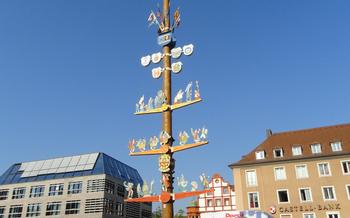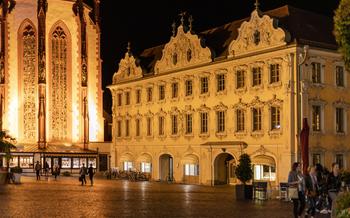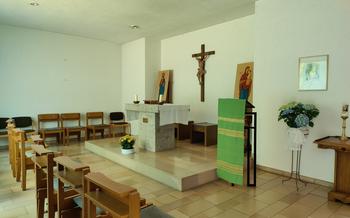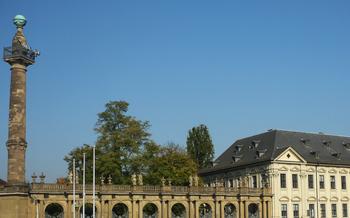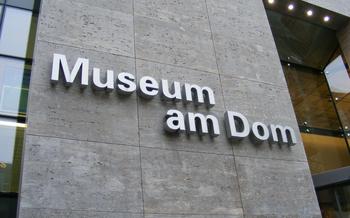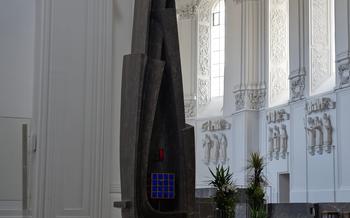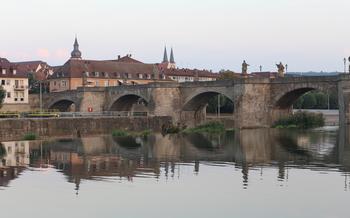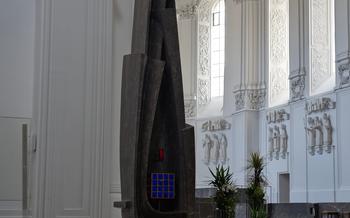
St. Mary's Chapel
- Historical Significance
- Altarpiece Masterpiece
- Architectural Marvel
- Sacred Ambiance: A Sanctuary of Peace and Reflection
- Pilgrimage Destination
- Cultural Landmark
- Guided Tours and Events
- Nearby Attractions
- Accessibility and Facilities
- Photography and Videography
- Dress Code and Etiquette
- History of Würzburg
- Accommodations and Lodging
- Insider Tip: Discover the Secret Chapel
Historical Significance
The St. Mary's Chapel, nestled in the heart of Würzburg, Germany, stands as a testament to the city's rich cultural and religious heritage. Its story begins in the 14th century, when it was constructed as a humble chapel dedicated to the Virgin Mary. Over time, the chapel gained prominence as a pilgrimage site, attracting devout believers from far and wide. Its reputation as a sacred destination grew, and it became an integral part of Würzburg's spiritual landscape.
The chapel's unique architectural style, blending Gothic and Renaissance elements, reflects the transition between two significant eras in European history. Its octagonal shape, a symbol of perfection and eternity, further enhances its spiritual significance. The chapel has stood the test of time, withstanding wars, fires, and societal changes, emerging as a symbol of resilience and faith. It remains a beloved landmark, cherished by locals and visitors alike, embodying Würzburg's deep-rooted connection to its religious heritage.
Altarpiece Masterpiece
The chapel's most renowned treasure is its stunning altarpiece, a masterpiece crafted by the renowned German sculptor Tilman Riemenschneider. Considered one of his greatest works, the altarpiece is a testament to Riemenschneider's exceptional skill and artistry. Carved from limewood with meticulous precision, the altarpiece depicts intricate scenes from the life of Mary and the passion of Christ.
The centerpiece of the altarpiece is a serene depiction of the Virgin Mary holding the infant Jesus, surrounded by angels and saints. The intricate details of the figures, from the delicate folds of their garments to the gentle expressions on their faces, showcase Riemenschneider's mastery of the human form. The altarpiece also features vivid portrayals of the crucifixion, resurrection, and ascension of Christ, each scene imbued with emotion and symbolism.
The altarpiece's symbolism is as rich as its artistry. The central figure of Mary represents the purity and grace of the Virgin, while the surrounding saints and angels symbolize the heavenly host. The scenes from Christ's life and passion evoke themes of suffering, redemption, and eternal salvation.
Visitors to the St. Mary's Chapel are often moved by the sheer beauty and craftsmanship of the altarpiece. The intricate carvings seem to come alive under the soft light filtering through the chapel's windows, creating a sense of awe and inspiration. The altarpiece has been described as a "symphony in wood," a testament to Riemenschneider's genius and the enduring power of religious art.
Architectural Marvel
The St. Mary's Chapel stands as a testament to the architectural brilliance of its time. Its octagonal shape, a rare feature in church architecture, symbolizes the perfection and eternity of God. The intricate stonework adorning the exterior showcases the skill and artistry of medieval craftsmen.
The chapel's construction techniques and materials reflect the durability and resilience that have allowed it to withstand the test of time. Constructed primarily of sandstone, the chapel's walls are adorned with delicate tracery, intricate carvings, and gargoyles that seem to come alive under the changing light.
The chapel's design was influenced by various architectural styles, including Gothic and Renaissance. The pointed arches and ribbed vaults evoke the Gothic style, while the use of classical elements such as pilasters and pediments hints at the influence of the Renaissance. This blend of styles creates a harmonious and visually striking edifice.
Sacred Ambiance: A Sanctuary of Peace and Reflection
The St. Mary's Chapel exudes a serene and spiritual atmosphere, inviting visitors to find solace, peace, and reflection within its hallowed walls. The muted light filtering through the stained-glass windows casts an ethereal glow, creating a sense of reverence and awe. The soft echoes of footsteps and hushed whispers add to the chapel's sacred ambiance, encouraging contemplation and introspection.
Natural light plays a crucial role in shaping the chapel's spiritual atmosphere. The carefully positioned windows allow shafts of sunlight to illuminate the intricate carvings and frescoes, revealing the hidden details and symbolic meanings embedded within the artwork. This play of light and shadow creates a dynamic and ever-changing tapestry, enhancing the visitor's experience.
The acoustics of the chapel are equally remarkable, contributing to its sacred ambiance. The vaulted ceilings and carefully crafted interior surfaces create a resonant space that enhances the sound of prayers, hymns, and music. Concerts and religious services held within the chapel are transformed into immersive experiences, as the acoustics envelop the audience, creating a sense of unity and transcendence.
Visitors to the St. Mary's Chapel often remark on the profound emotional and spiritual connection they feel within its sacred space. The chapel's serene atmosphere, coupled with its stunning beauty and rich history, creates a sanctuary where visitors can connect with their inner selves, seek solace, and find spiritual renewal.
Pilgrimage Destination
The St. Mary's Chapel is a renowned pilgrimage site, drawing visitors from near and far who seek spiritual renewal and connection with the divine. The chapel's association with the Virgin Mary holds immense significance in Catholic pilgrimage traditions, as Mary is revered as a symbol of purity, compassion, and divine grace. Pilgrims from all walks of life flock to the chapel to pay homage to the Virgin Mary, seeking her intercession and blessings. They often partake in various rituals and practices associated with pilgrimage, such as lighting candles, offering prayers, and participating in religious services. For many pilgrims, the St. Mary's Chapel represents a sacred space where they can find solace, spiritual growth, and healing through their devotion to the Virgin Mary.
Cultural Landmark
The St. Mary's Chapel is not just a religious site but also a significant cultural landmark recognized for its historical, artistic, and religious value. Its inclusion on the UNESCO World Heritage List in 1981 is a testament to its outstanding universal value. The chapel meets several criteria for inclusion on the list, including its representation of a unique architectural style that combines Gothic and Renaissance elements, its exceptional artwork and craftsmanship, and its profound impact on the cultural and religious landscape of Germany.
The chapel has played a vital role in promoting cultural exchange and understanding between different countries and cultures. Its unique blend of architectural styles reflects the influence of various artistic movements and traditions, showcasing the cultural diversity and richness of the region. The chapel's history and significance have attracted visitors from around the world, fostering an atmosphere of mutual respect and appreciation for diverse cultures and beliefs.
Furthermore, the chapel has served as a source of inspiration and creativity for artists, writers, and musicians throughout history. Its stunning architecture and intricate artwork have been the subject of numerous paintings, poems, and musical compositions, contributing to the cultural heritage of Germany and beyond. The chapel's enduring legacy as a cultural landmark continues to attract visitors who seek to experience its beauty, history, and profound cultural significance.
Guided Tours and Events
To fully appreciate the chapel's historical and artistic significance, join a guided tour led by knowledgeable experts. These tours offer insightful commentary, revealing the stories behind the chapel's construction, architecture, and artwork. Guides bring the chapel to life, sharing anecdotes and historical facts that enhance your understanding and appreciation.
The chapel also hosts special events and concerts that add to its cultural and spiritual experience. Attend a religious service, where the chapel's acoustics create an awe-inspiring atmosphere for worship. Immerse yourself in the enchanting sounds of classical music concerts, where the chapel's intimate setting provides an unforgettable musical encounter.
To ensure a seamless visit, book your guided tour or concert tickets in advance. Check the chapel's website for schedules and availability. Avoid peak tourist hours, especially during the summer months, to enjoy a more tranquil experience.
Nearby Attractions
After exploring the St. Mary's Chapel, visitors can venture into the heart of Würzburg to discover a wealth of nearby attractions. A short walk away lies the Würzburg Cathedral, an awe-inspiring masterpiece of Romanesque and Gothic architecture. Its grand spires dominate the city skyline and offer breathtaking views from the top.
Just a stone's throw from the cathedral is the Residenz, the former palace of the prince-bishops of Würzburg. This magnificent Baroque palace is a UNESCO World Heritage Site and boasts opulent interiors, exquisite gardens, and a world-class collection of art and artifacts.
For those seeking a unique cultural experience, the Museum am Dom showcases an impressive collection of medieval and modern art, including works by Tilman Riemenschneider and other renowned artists. The Martin von Wagner Museum delves into the region's history and folklore, offering insights into the lives and traditions of the local people.
To immerse oneself in the city's vibrant atmosphere, visitors can stroll along the Alte Mainbrücke, a picturesque bridge lined with charming shops and restaurants. The bridge offers stunning views of the river Main and the surrounding cityscape.
For a leisurely afternoon, visitors can explore the Hofgarten, a beautiful park located just a short walk from the chapel. With its tranquil ponds, lush greenery, and elegant sculptures, the Hofgarten is a perfect place to relax and unwind.
Accessibility and Facilities
The St. Mary's Chapel is committed to ensuring accessibility for visitors with disabilities. Wheelchair ramps and accessible restrooms are available, allowing everyone to experience the chapel's beauty and spiritual atmosphere.
Visitor facilities include restrooms, a gift shop, and a café or restaurant. The gift shop offers a variety of souvenirs and religious items, while the café or restaurant provides a place to relax and enjoy a light meal or snack.
The chapel's opening hours are typically from 9 am to 6 pm daily, but it is advisable to check the official website or contact the chapel directly for any changes or special events. Admission to the chapel is free of charge, allowing visitors from all backgrounds to experience its wonders.
To plan a visit, it is recommended to avoid peak tourist hours, which are usually in the late morning and early afternoon. The best time to visit is early in the morning or late in the afternoon, when the crowds are smaller and the atmosphere is more serene. The recommended duration of a visit is approximately one hour, allowing ample time to explore the chapel's interior and soak in its spiritual ambiance.
Photography and Videography
The St. Mary's Chapel welcomes visitors to capture the beauty of its interior and exterior through photography and videography. However, to maintain the sacredness of the space, certain guidelines are in place. Visitors are kindly requested to refrain from using flash photography or tripods inside the chapel, as these can be disruptive to other visitors and may damage the delicate artwork and artifacts. It is also important to be mindful of the privacy of other visitors and avoid taking photos or videos of individuals without their consent.
When capturing the chapel's stunning architecture and intricate details, consider the lighting conditions to make the most of the natural light streaming through the stained glass windows. Experiment with different angles and perspectives to create unique and visually appealing shots. Remember to respect the sanctity of the chapel and avoid using the space for commercial purposes without prior permission from the church authorities.
By following these guidelines, visitors can document their visit to the St. Mary's Chapel while preserving its sacred atmosphere and respecting the religious significance of this historic landmark.
Dress Code and Etiquette
When visiting St. Mary's Chapel, it is essential to observe proper dress code and etiquette out of respect for the sacred nature of the site. While there is no strict dress code, visitors should dress modestly and conservatively, avoiding revealing or overly casual attire. It is customary to cover shoulders and knees, and to avoid wearing shorts, tank tops, or flip-flops.
Maintaining silence and refraining from disruptive behavior is expected within the chapel. Visitors should be mindful of the ongoing religious services or prayers and avoid talking, laughing, or taking loud phone calls. Photography and videography are generally allowed, but visitors should be discreet and avoid using flash or disturbing others.
It is considered respectful to bow or kneel in prayer upon entering the chapel, as a sign of reverence for the sacred space. This simple gesture demonstrates respect for the religious significance of the chapel and contributes to the peaceful and contemplative atmosphere.
History of Würzburg
Würzburg, a city steeped in history and culture, boasts a rich tapestry of events that have shaped its identity. The city's roots can be traced back to the 7th century when it was a modest settlement on the banks of the Main River. Over the centuries, Würzburg flourished as a religious and cultural center, largely due to the influence of the prince-bishops who ruled the city-state.
The St. Mary's Chapel, standing as a testament to Würzburg's rich heritage, played a pivotal role in shaping the city's religious and cultural landscape. Built in the 14th century, the chapel became a renowned pilgrimage site, attracting devout visitors from far and wide. Its exquisite architecture, awe-inspiring altarpiece, and spiritual aura contributed significantly to Würzburg's reputation as a center of pilgrimage and devotion.
Throughout history, Würzburg witnessed numerous significant events, including the Peasant's War of 1525, the Thirty Years' War, and the Napoleonic Wars. Despite the trials and tribulations it faced, Würzburg emerged as a resilient city, preserving its cultural and religious heritage while embracing modernity.
Today, Würzburg is a vibrant and cosmopolitan city that seamlessly blends its rich history with contemporary life. Visitors can explore the city's many historical landmarks, including the majestic Würzburg Residence, a UNESCO World Heritage Site, and the Alte Mainbrücke, an iconic bridge adorned with statues of saints. The city's museums, theaters, and cultural events further enhance its appeal, making Würzburg a delightful destination for history buffs and culture enthusiasts alike.
Accommodations and Lodging
For a comfortable and convenient stay within walking distance of the St. Mary's Chapel, consider the Hotel Würzburger Hof. This elegant hotel offers spacious rooms and suites, many with stunning views of the chapel and the city skyline. Enjoy modern amenities, a delicious breakfast buffet, and a cozy bar for evening drinks. Its central location allows for easy exploration of Würzburg's other attractions, including the Residenz and the Old Main Bridge.
Alternatively, for a more budget-friendly option, try the Gästehaus am Dom. This charming guesthouse offers simple but clean and comfortable rooms, perfect for budget travelers or those seeking a more local experience. Located just a short walk from the chapel, it's an excellent base for exploring the city on foot.
If you prefer a more immersive experience, consider staying at the Kloster St. Stephan. This former monastery offers unique accommodations within the historic walls of the city center. Choose from cozy rooms or spacious apartments, each with its own character and charm. Enjoy the tranquil atmosphere of the cloister garden and the opportunity to engage with the friendly Benedictine monks who reside there.
Insider Tip: Discover the Secret Chapel
Unveiling the hidden gem of the St. Mary's Chapel, the Marienkapelle, nestled within the cloisters of the Neumünster Abbey, offers a serene sanctuary away from the bustling city center. This lesser-known chapel boasts stunning frescoes and intricate carvings that rival those of the main chapel.
To access this hidden treasure, visitors can stroll through the peaceful abbey courtyard and follow the signs leading to the Marienkapelle. Once inside, they will be captivated by the vibrant colors and meticulous details that adorn the chapel's walls and ceiling.
This insider tip is perfect for those seeking a moment of tranquility and reflection amidst the grandeur of Würzburg's religious landmarks. Whether visitors are art enthusiasts, history buffs, or simply curious travelers, the Marienkapelle promises an unforgettable experience that will leave them in awe.
